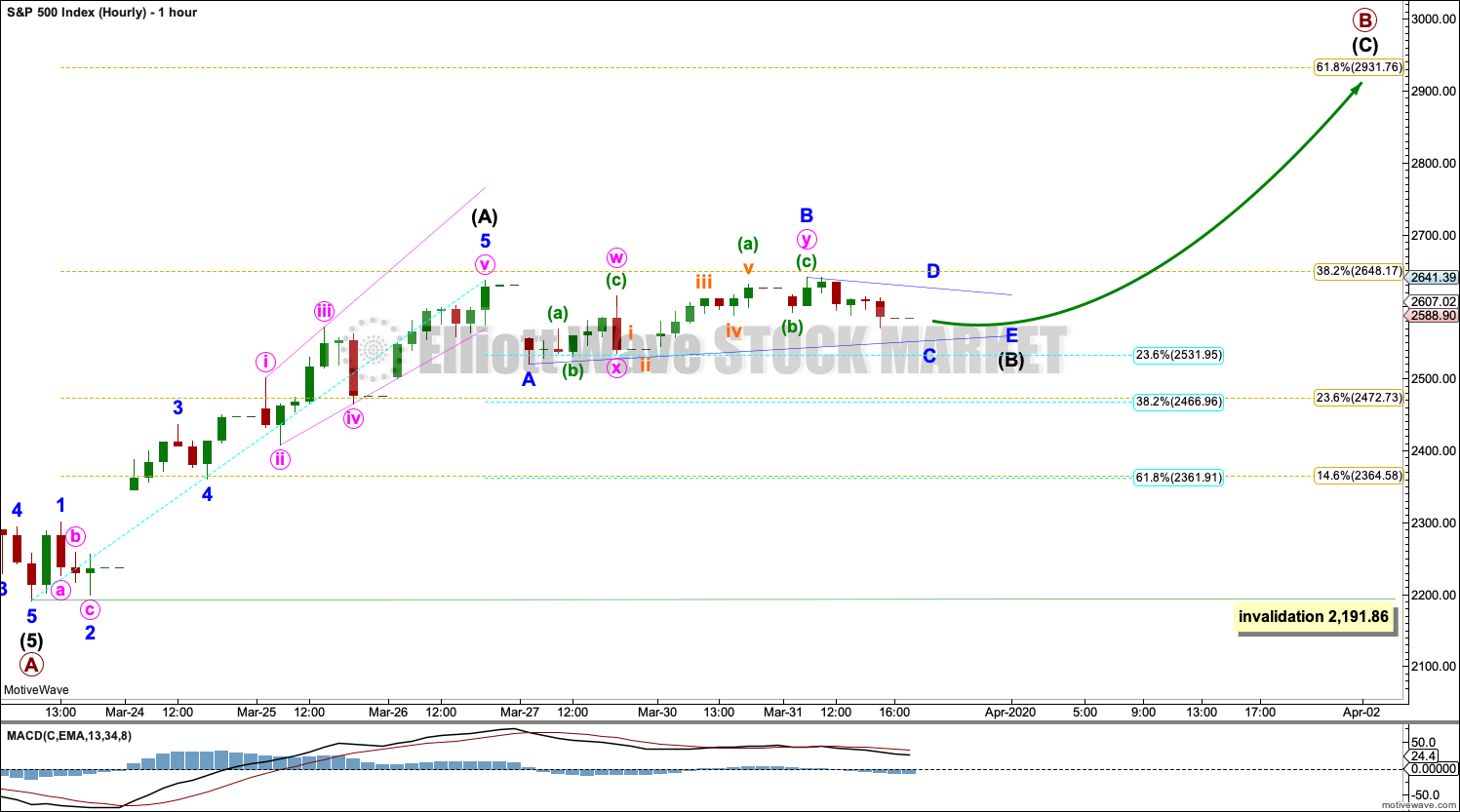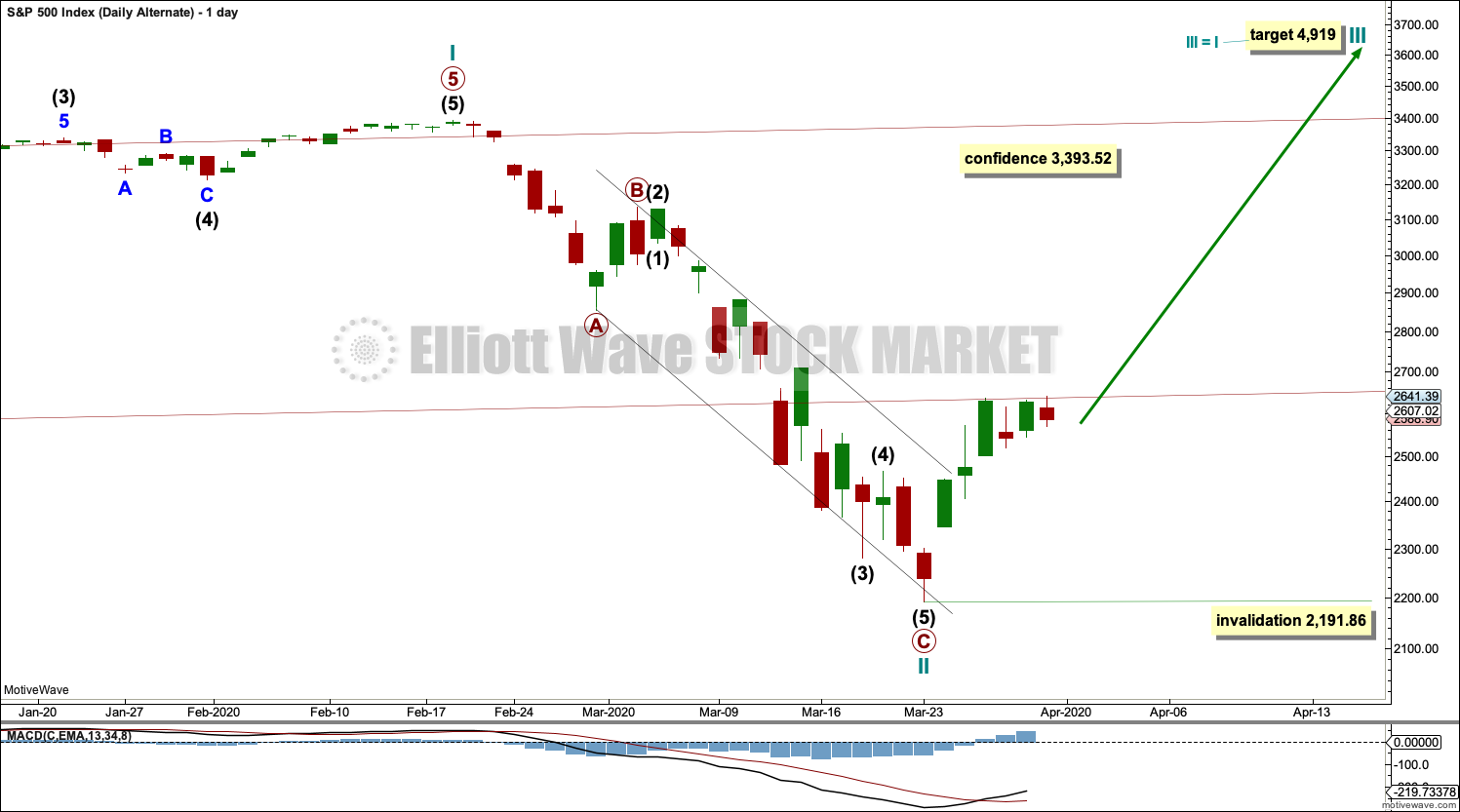S&P 500: Elliott Wave and Technical Analysis | Charts – March 31, 2020
Analysis has expected price to move sideways or lower this week. Sideways movement today fits overall expectations. Price may continue to hug the lower edge of a multi-year channel.
Summary: Primary wave B may have begun. It may be either a quick sharp bounce or a long lasting sideways consolidation. Targets are 2,651 or 2,934.
This week expect downwards or sideways movement as intermediate (B) within primary wave B unfolds. So far price is finding resistance at the lower edge of the channel on the weekly and daily charts. If resistance holds, then primary wave B may continue to be shallow.
The biggest picture, Grand Super Cycle analysis, is here.
Last monthly charts are here. Video is here. Members are encouraged to view all three monthly charts. The third is much more bearish than this main wave count and remains a valid possibility.
ELLIOTT WAVE COUNTS
WEEKLY CHART
The channel is now breached by a full weekly candlestick below and not touching the lower edge. Further confidence in this wave count may be had. The lower edge of this channel is continuing so far to provide resistance.
Price is now below the 0.382 Fibonacci ratio of cycle wave I at 2,352. The structure of cycle wave II may need further to go to complete. The next Fibonacci ratio at 0.618 is now a preferred target for cycle wave II to end.
Cycle wave II would most likely subdivide as a zigzag; thus far that looks like what it is unfolding. When primary waves A and B may both be complete, then the target may be calculated using a Fibonacci ratio between primary waves A and C. At that stage, the final target may change or widen to a zone.
Cycle wave II may not move beyond the start of cycle wave I below 666.79.
DAILY CHART
Redraw the wide maroon trend channel carefully: draw the first trend line from the end of primary wave 1 at 2,093.55 (December 26, 2014), to the end of primary wave 3 at 2,940.91 (September 21, 2018), then place a parallel copy on the end of primary wave 2 at 1,810.10 (February 11, 2016). The channel is fully breached indicating a trend change from the multi-year bull trend to a new bear trend. The lower edge may now be an important line of resistance. If resistance at this line holds, then primary wave B may end close to the 0.382 Fibonacci ratio of primary wave A at 2,651.
Cycle wave II may subdivide as any Elliott wave corrective structure except a triangle. It would most likely be a zigzag. Primary wave A may be a complete five wave impulse. Primary wave B may not move beyond the start of primary wave A above 3,393.52.
HOURLY CHART
Primary wave B may subdivide as any one of more than 23 possible Elliott wave corrective structures. B waves exhibit the greatest variety in structure and price behaviour. Primary wave B may be a quick sharp bounce as in a single or multiple zigzag, or it may be a time consuming sideways consolidation as in a flat, combination or triangle.
This main hourly wave count considers the possibility that primary wave B may be subdividing as a zigzag. If primary wave B subdivides as a zigzag, then intermediate wave (A) must subdivide as a five wave motive structure, most likely an impulse.
Intermediate wave (A) should now be over.
If intermediate wave (A) has subdivided as a five wave structure, then intermediate wave (B) may not move beyond its start below 2,191.86.
Intermediate wave (B) may subdivide as any Elliott wave corrective structure. It wold most likely subdivide as a zigzag as labelled. However, B waves within B waves are the most difficult piece of any correction to analyse. The labelling within intermediate wave (B) will likely change again as it continues. Intermediate wave (B) may end about either the 0.382 Fibonacci ratio of intermediate wave (A) at 2,467, or the 0.618 Fibonacci ratio at 2,362. Neither may be favoured.
If primary wave A is correctly analysed as a five wave impulse, then primary wave B may not move beyond its start above 3,393.52.
ALTERNATE HOURLY CHART
It is also possible that primary wave B may subdivide as a flat, combination or triangle. This alternate wave count considers those possibilities in the one chart.
If primary wave B subdivides as any one of a flat, combination or triangle, then the first wave up within it should subdivide as a three, most likely a zigzag.
If primary wave B subdivides as a flat correction, then within it intermediate wave (A) may be complete. Intermediate wave (B) would need to retrace a minimum 0.9 length of intermediate wave (A). Intermediate wave (B) may make a new low below the start of intermediate wave (A) at 2,191.86 as in an expanded flat. There is no lower invalidation point. Intermediate wave (B) may be subdividing as a flat correction.
If primary wave B subdivides as a double combination, then the first structure in a combination may be complete, a zigzag labelled intermediate wave (W). The double may then be joined by a three in the opposite direction to be labelled intermediate wave (X), which would most likely subdivide as a zigzag. There is no minimum requirement for intermediate wave (X) and it may make a new low below the start of intermediate wave (W). There is no lower invalidation point.
Primary wave B may not be subdividing as a triangle if intermediate wave (A) is complete at the high labelled. Intermediate wave (B) within a triangle may not subdivide as a flat correction.
ALTERNATE DAILY CHART
It is possible that cycle wave II may be over. However, this alternate wave count has a very low probability. This wave count requires a new all time high for confidence.
This wave count has a low probability mostly because we should assume the trend remains the same until proven otherwise. The trend is currently down.
Although the bounce began with strength, declining ATR and weak momentum of the last few days suggest a counter trend movement and not a new bullish trend.
TECHNICAL ANALYSIS
WEEKLY CHART

Click chart to enlarge. Chart courtesy of StockCharts.com.
A bounce has arrived within the bear market. It may continue further.
DAILY CHART
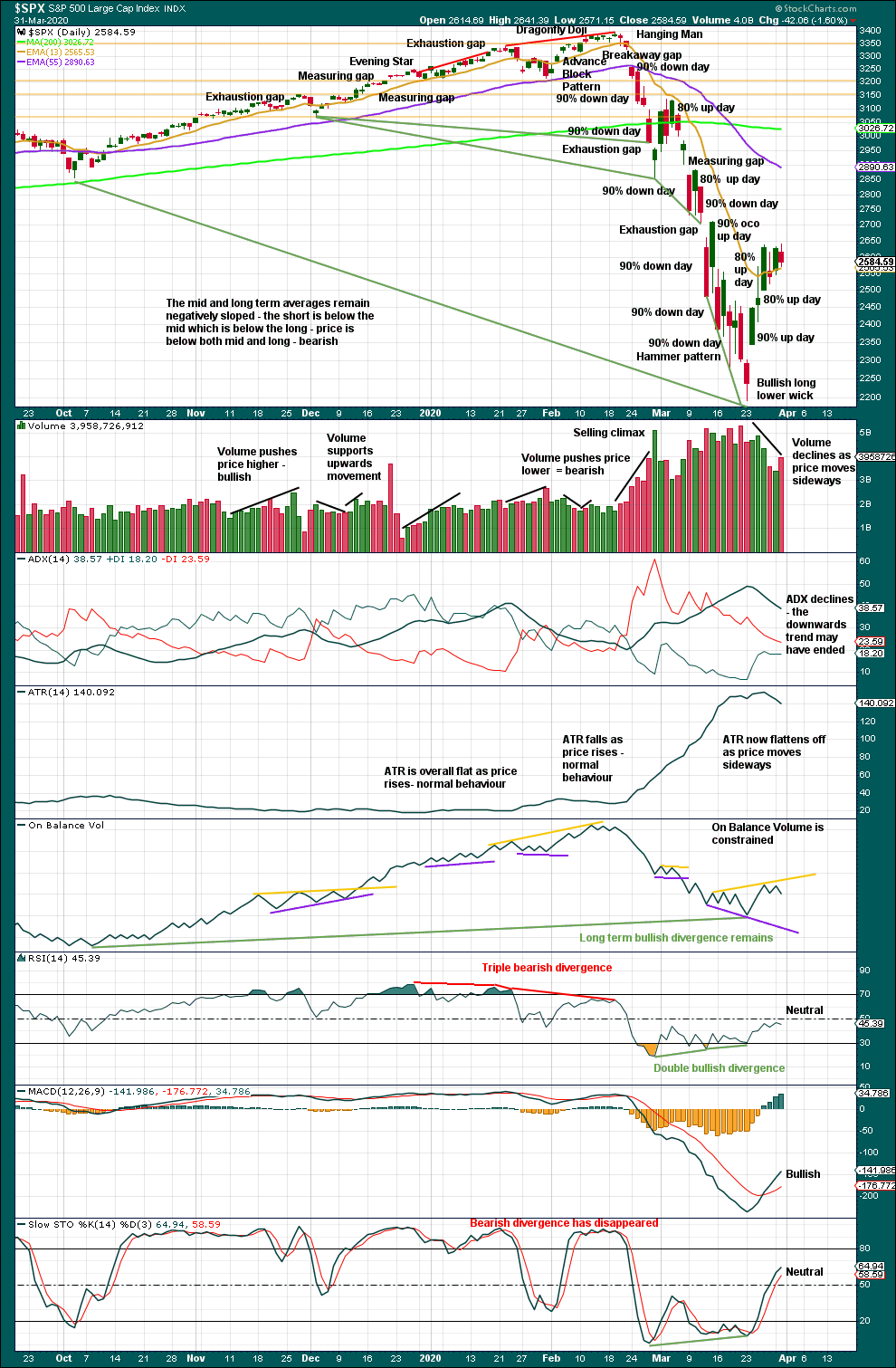
Click chart to enlarge. Chart courtesy of StockCharts.com.
There are now eight 90% downwards days in this strong downwards movement.
At the last low:
– RSI reached deeply oversold and now exhibits short-term double bullish divergence with price.
– Stochastics reached oversold and now exhibits short-term bullish divergence with price.
– On Balance Volume exhibited bullish divergence with price, although short-term bullish divergence disappeared.
Now a 90% upwards day and two back to back 80% upwards days give strong confidence that a low is in place. It may not be the end of the bear market though; the Elliott wave structure may not be complete.
A correction within the bear market looks to have arrived. It would be reasonable to expect choppy overlapping movement for at least a week or so, possibly over a month.
For the short term, some increase in volume today for downwards movement within this session may be bearish.
To see what signals may be looked for to identify a high, the two previous large bear markets will be analysed in end of week analysis. The DotCom crash was analysed last week here with video here.
BREADTH – AD LINE
WEEKLY CHART
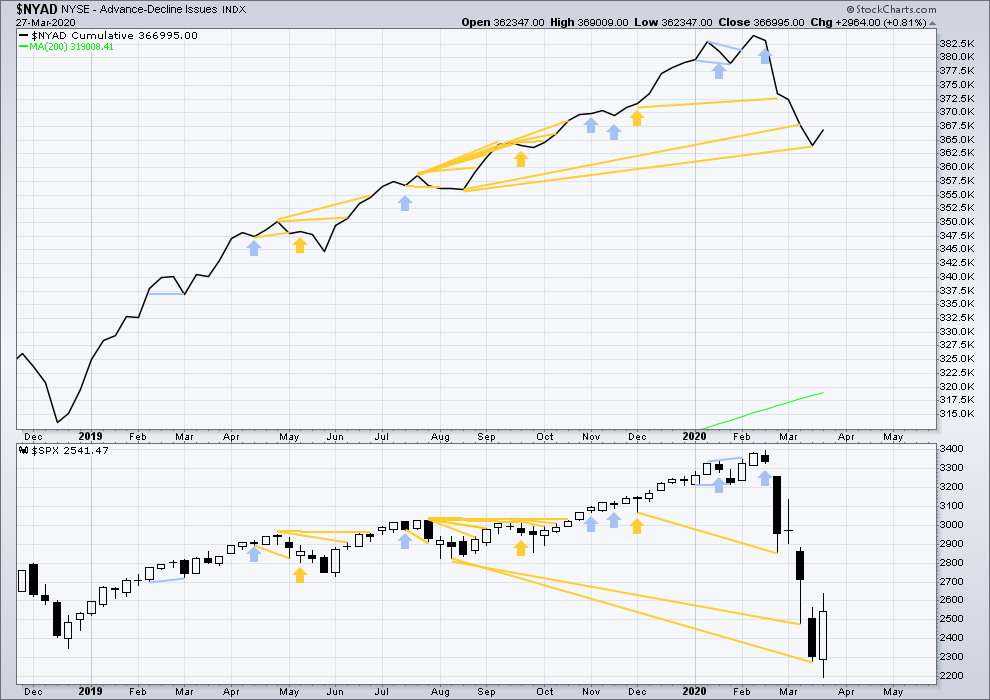
Click chart to enlarge. Chart courtesy of StockCharts.com. So that colour blind members are included, bearish signals will be noted with blue and bullish signals with yellow.
Bear markets from the Great Depression and onwards have been preceded by an average minimum of 4 months divergence between price and the AD line with only two exceptions in 1946 and 1976. With no divergence between the AD line and price at the last all time high, this current bear market now makes a third exception.
In all bear markets in the last 90 years there is some positive correlation (0.6022) between the length of bearish divergence and the depth of the following bear market. No to little divergence is correlated with more shallow bear markets. Longer divergence is correlated with deeper bear markets.
This bear market comes after no bearish divergence. It would more likely be shallow, but this is a statement of probability and not certainty. So far it is slightly more than the 0.382 Fibonacci ratio of the bull market it is correcting (beginning March 2009).
Last week an outside week closes green and the AD line supports upwards movement within the week. There is no new divergence.
Large caps all time high: 3,393.52 on 19th February 2020.
Mid caps all time high: 2,109.43 on 20th February 2020.
Small caps all time high: 1,100.58 on 27th August 2018.
DAILY CHART
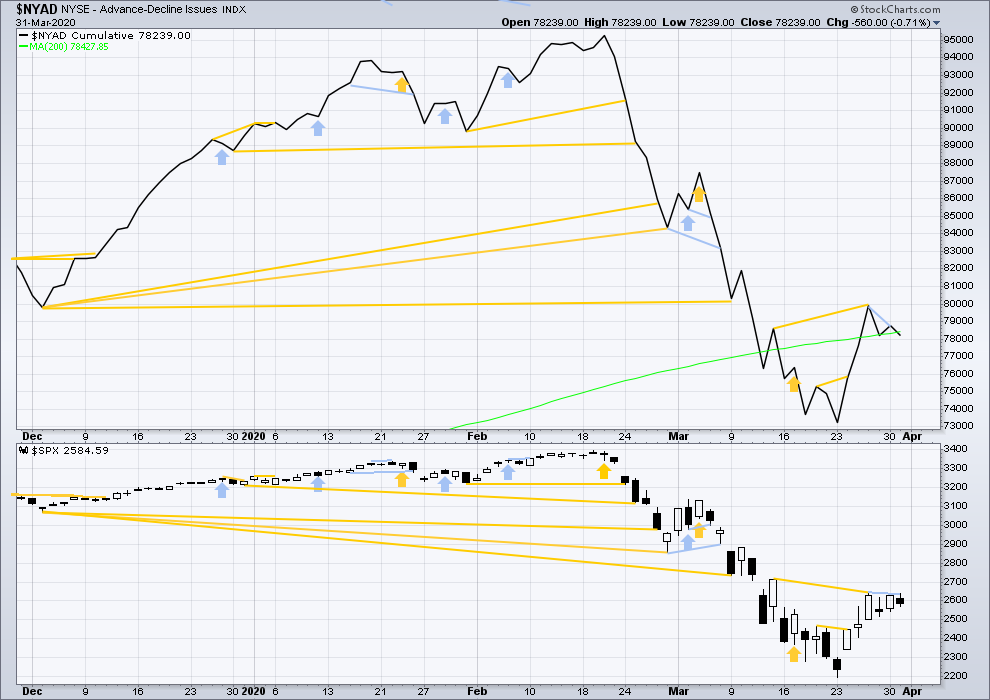
Click chart to enlarge. Chart courtesy of StockCharts.com. So that colour blind members are included, bearish signals will be noted with blue and bullish signals with yellow.
Breadth should be read as a leading indicator.
Today price moved higher although the candlestick closed red. The AD line has declined.
Price has made a very slight new high, but the AD line has not. This divergence is bearish but weak.
VOLATILITY – INVERTED VIX CHART
WEEKLY CHART

Click chart to enlarge. Chart courtesy of StockCharts.com. So that colour blind members are included, bearish signals will be noted with blue and bullish signals with yellow.
Last week completes an outside week, which has closed green, and inverted VIX is overall flat. There is no new short-term divergence.
DAILY CHART
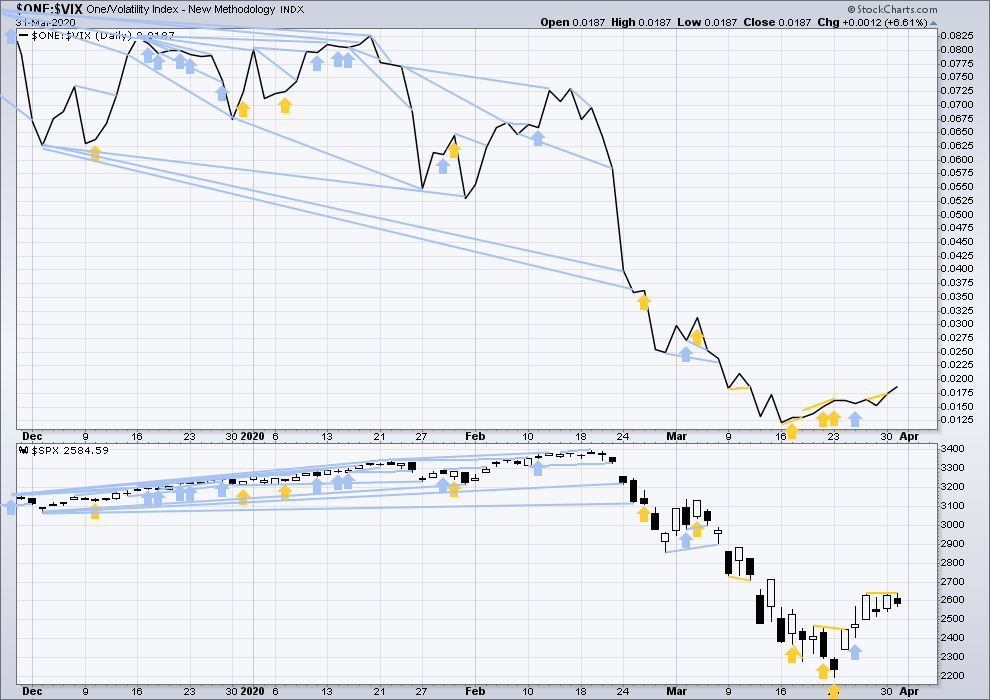
Click chart to enlarge. Chart courtesy of StockCharts.com. So that colour blind members are included, bearish signals will be noted with blue and bullish signals with yellow.
Today both price and inverted VIX have moved higher to make new short-term highs. There is no new divergence.
DOW THEORY
Dow Theory has confirmed a bear market with the following lows made on a closing basis:
DJIA: 21,712.53 – a close below this point has been made on the March 12, 2020.
DJT: 8,636.79 – a close below this point has been made on March 9, 2020.
Adding in the S&P and Nasdaq for an extended Dow Theory, a bear market has now been confirmed:
S&P500: 2,346.58 – a close below this point has now been made on March 20, 2020.
Nasdaq: 7,292.22 – a close below this point was made on the March 12, 2020.
Published @ 07:18 p.m. EST.
—
Careful risk management protects your trading account(s).
Follow my two Golden Rules:
1. Always trade with stops.
2. Risk only 1-5% of equity on any one trade.
—
New updates to this analysis are in bold.



